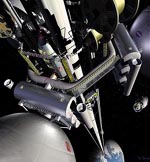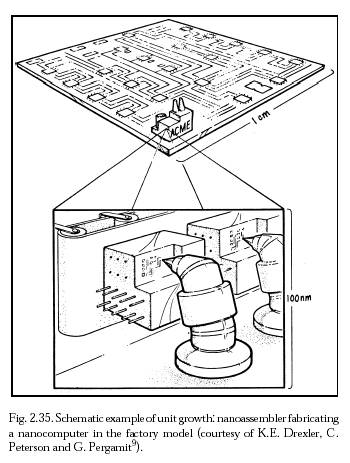Tinkering with various electronics and software things, and a bit of math and science in general.
Wednesday, November 23, 2005
Investing in nanotechnology today
Nanovip is a database of businesses involved in nanotechnology, organized by industry. There is information about funding, software, MEMS, tools and instruments, and nanotube suppliers.
There is another nanotech business portal at nanotechnology.com. It's nice that their research section is about scientific and technological research, and separate from their financial section. One of the regular columnists there seems to think we're in the midst of a sea change. They've even got a blog.
There's another blog by Steve Forbes and Josh Wolfe that frequently touches on topics of nanotechnology and investing.
Another interesting site is NanotechnologyInvestment.com. There I learned that there are now venture capitalists who specialize in nanotechnology. Merrill Lynch has a nanotech index.
The ventures described are working with the technology available today. From the perspective of the longer-term outlook described in other postings, these efforts will seem as primitive as a blacksmith's work seems today. Their range of uses will be quite limited compared to what else will then be available.
Monday, November 21, 2005
Steps along the way
The tweezers were cool but they obviously didn't usher in a brave new world of full-blown nanotechnology. So it's got to be small, but it's also got to be capable. And because we want to tell it what to do, it needs to be controllable from the human scale.
Chris Schafmeister at the University of Pittsburgh is considerably further along. His lab has figured out a Lego set of little molecules that snap together rigidly into any shape. Schafmeister can control the assembly sequence and therefore control what shape he gets.

Peixuan Guo at Purdue is doing some similarly interesting stuff with RNA. This work has already resulted in more specific delivery systems for chemotherapeutic drugs used to treat cancer.
Another promising direction is to harness ribosomes, the widgets inside our cells that produce proteins. We can specify any DNA sequence we want, so we can instruct ribosomes to build any of a wide variety of novel human-designed proteins. We are already doing some of that; what we need to do more is to understand proteins better. Some of that is science, but a lot of it is just simulation horsepower.
Saturday, November 12, 2005
Nanotechnology's long-term prospects
That's not really very interesting or ground-shaking. These are instances where we are building teeny things with existing machines. The exciting nanotechnology is when you build things with teeny machines. So far, we don't have teeny machines. Nature does, and some researchers are investigating that route. Nature's machines have evolved to do very specific jobs and making them do other jobs takes a lot of ingenuity, when it's possible at all.
The currently popular definition for nanotechnology is objects with feature sizes of about a nanometer. But with that definition we don't get medical nanobots....

or space elevators....

or nanocomputers....

...or possible solutions to a host of other social ills.
Working at Nanorex

The company founder has made several other significant contributions to the development of nanotechnology, including a lot of support for the nanofactory animation. We are in discussions with just about everybody interested in the direction of nanotech CAD software. I myself have thought about nanotech CAD software in past years.
It's important that nanoENGINEER-1 be open-source, even if we have to delay getting revenue for a while. In a world that's rapidly approaching real nanotech, we don't want a big gap between the haves and the have-nots. There are a lot of important policy discussions that need to take place, and it's good if the largest possible number of people are able to follow and participate in those discussions. Tools like nanoENGINEER-1 can help people to study nanotechnology proposals and understand how the technology will work.
The RepRap Project, and globalization
The idea is that it should be open-sourced, and that it should be possible (with human involvement) to use one to make another, in addition to making many other useful things. The idea is to decentralize and spread and commoditize the benefits of the Industrial Revolution to ease the plight of poverty everywhere. For this reason, the RepRap guys have decided to GPL everything they do. The RepRap tool becomes cheap because one RepRap can be used to make another. This is a very powerful idea.
The RepRap doesn't accept natural materials (rocks, bark, twigs, dirt) as raw materials. The villager who wants to make a widget for his family must be able to buy or barter for raw materials. Stuff doesn't become free, but it does become much cheaper. The same globalization that hurts workers in the developed world helps the developing-world villager.
Building a complete self-replicative manufacturing unit in another country would be a ridiculously expensive undertaking. Training, machine tools, buildings - millions or billions of dollars involved. Its size would necessitate organizing it as several individual businesses that buy and sell intermediate products to one another, and there'd be business failures.
People gripe about how Walmart is destroying American jobs, but Walmart is simply hastening the approach of an inevitable economic equilibrium, Developing countries (primarily China) are getting paid to build more manufacturing infrastructure for themselves. Japan ate our manufacturing lunch in the 1980s, today China is eating Japan's lunch.
The economic long term equilibrium outlook: The whole world is "developed". American wages drop, wages elsewhere rise, eventually all that settles. Speaking as a comfortable middle-aged American, I can't say I look forward gleefully to my own plight in the coming decades, but hopefully development will help the rest of the world.
The post-scarcity economy
The phrase post-scarcity economy was coined in the 1950s by economist Louis Kelso, but it could have been envisioned any time after the Industrial Revolution. The idea is that automation drives down the price of all goods to effectively zero, money becomes meaningless, and the entire population goes on perpetual vacation.
I want to distinguish between what venture capitalists call "nanotechnology" today and the real thing. The quickest way to do that is to refer you to Ralph Merkle's website, or the Wikipedia article. When referring to real nanotechnology, I'll use the abbreviation "MNT".
Many have conjectured that MNT will bring about a post-scarcity economy. There is also conjecture that sophisticated robots could do the same without nanotechnology (see Marshall Brain's novella Manna). In the robot case, an important axiom is that the robots can build more robots, thereby driving down the price of robots. The same axiom exists in the nanotech case; nanotech fabricators can make more nanotech fabricators.
The big idea here is self-replication. A robot is self-replicating if it can build a copy of itself from the available raw materials. The idea is that the first robot costs a huge amount in development, and every robot after that is free because it's built by another robot. But available raw materials turns out to be a fly in the ointment. If the raw materials are sand and gravel, then robots are indeed cheap. But if the necessary raw materials are subassemblies from Home Depot and Radio Shack, then robots can't get any cheaper than the stuff you need to buy for the next one to be built. The price of raw materials plays a very important limiting role in this picture of abundant free robots doing all our work for us.
For a robot to build more robots from sand and gravel, it must replicate all the arts of ore mining, metal smelting, and machining, to make just the metal parts. There will also be rubber and plastic parts, and probably silicon electronic parts. The "self-replicative robot" probably now occupies several acres, and is really a self-replicating robot factory, producing both robots and more robot factories. In order to accept cheaper less-organized raw materials, the unit of replication needs to be more complex.
MNT simplifies matters somewhat. Products are built out of carbon and other common elements, "machining" is done at a molecular level, and no smelting is needed. Putting all the pieces together into one desktop nanofactory becomes feasible. The raw materials are atoms (dirt, air, water), time, energy, and software.
Sometimes, what we really want from a post-scarcity economy is self-sufficiency. Complete self-sufficiency means that you can trundle off into the woods, build a log cabin, catch your own food, make your own clothers, and perform your own medical services. A nanofactory will make all that much more practical.
In the meanwhile, a limited form of self-sufficiency is the freedom to choose whether or not to trade with other people or businesses. This is feasible as long as the things I'm buying aren't products made by monopolies.
Nanofactories
Recently I've been thinking a good deal about Foresight's efforts to animate a nanofactory (see the slideshow) and turn it into a DVD, with presumably wide distribution.
Click here for larger image.
This was originally blogged in December 2004. Since that time, a very pretty final version has been finished, which you can find on Foresight's website or at Google Video.
I like this idea a lot. I think it can impress upon people that nanotech is really a pretty simple idea (although some of the engineering details will be quite complicated). Right now, the possibility of really mature nanotechnology ("make anything that doesn't violate the laws of physics") is probably viewed by most people as centuries in the future, if it's on their radar at all. The real point of the DVD is that this stuff isn't incomprehensible, and it needn't wait 50 or 100 years to happen. That's important, because there are huge benefits to be gained, particularly in terms of human health and longevity, and the sooner they come, the better.
The public relations effort to put real nanotechnology on the map is important. It would be particularly valuable for the medical profession to wrap their brains around this. If a doctor starts to advocate for real nanotech, maybe some of his patients are CEOs or senators. Maybe the doctor mentions that nanotech will usher in an age of treatments that, today, we could only call "miracle cures". Maybe the next bill before Congress advocating nanotech research says, hey, let's throw some money at the real thing, rather than mislabelled silly tricks.